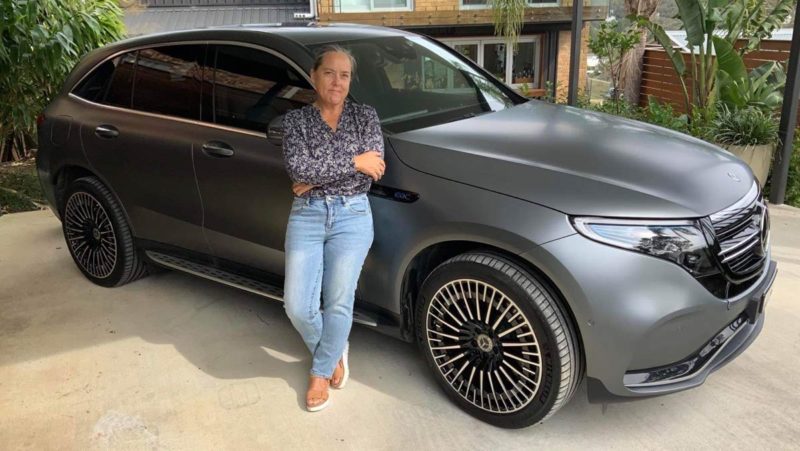Tiffany Overton is only the third woman to drive solo around Australia in an EV.
It’s a simple statement that belies some hard truths. One, that there have only been an estimated 20 people to date who are known to have completed the “Big Lap” in an EV – across remote expanses of the outback with little in the way of electric car chargers.
Doing the trip in itself is a feat. Doing it solo as a woman in something else. And, it’s been something that hasn’t been done since the late Linda Rohrs – who followed in the footsteps of the pioneering Sylvia Wilson – did the trip in 2019, taking a leisurely 80 days to drive 17,000km in her Tesla Model S.
When I spoke to Overton about her recent lap around Australia, she wasn’t her aware she had achieved the title of third woman to do the trip solo (well, mostly solo – her husband joined her for a small section so the two could visit the Adelaide Hills.)
As she put it, “It was just what I did.”
But not only did she become the third woman to drive around Australia in an EV, she became the first to do it in a non-Tesla vehicle.
Specifically, she did the drive in a Mercedes-Benz EQC. This is the German carmaker’s all-electric version of the GLC, a roomy and very comfortably appointed medium-sized SUV. It is has an 80kWh battery, and is rated for 417 WLTP driving range, but in reality probably offers around 350km on a smooth road.
On a chipseal outback road, it offers even less range.

“It was an adventure,” Overton, who hails originally from Virginia, USA, and arrived in Australia 10 years ago, tells The Driven. “And it was fabulous to get to see the country. I got my citizenship in December and decided that an electric car and a lap around Australia to kind of get to know my new country would be good.”
Taking advantage of five year’s worth of free charging from Chargefox that came with the EQC, Overton started out in Copacabana on the central coast of NSW. She says she took her time exploring sections of the NSW south coast affected by the 2020 fires and then the Victorian east coast and Wilson’s Prom before heading to Melbourne for some work meetings.
After this she headed to Adelaide to pick up her husband and to do a little wine tasting together in the Adelaide Hills and diving at Whyalla.
“So we drove there and dove together and then went as far as Port Lincoln and then I put him back on a plane to go back to work and I continued on alone,” she says.

That’s when the EV road trip adventure truly began.
“I kept going (west) on to Coffin Bay, Venus Bay, Streaky Bay,” she says. Then of course she hit the Nullarbor, before heading over to the west coast of WA.
“I did Shark Bay, Exmouth, Broome, then I went up to Derby, and did Litchfield National Park and Darwin and Kakadu. And then the decision was, do I go down the red center? Or do I go back on fast chargers and home?”
“And so I decided that now is the time to do the adventure. So I went down the centre to Pine Creek and Daly Waters and Uluru and all of that. Then I turned right and went home via Broken Hill,” she says.
Choosing a Mercedes-Benz EQC over a Tesla
The significance of Overton doing the trip in an EQC is not just because she was not able to use the Tesla Supercharger network, significantly reducing the number of DC fast chargers she had to choose from in more populated areas of the country.
It also means that in the stretches of remote roads where there are only AC chargers available, she was at an additional disadvantage. Her 2020 EQC can charge at a top AC rate of 7kW compared to the higher rates (between 11kW and 22kW depending on their vehicle age) that Linda Rohrs and Sylvia Wilson’s Tesla Model S were capable of.
It means that for every hour of charging at 7kW, just 40km of driving range is added to the battery’s state of charge (SoC).
This clearly didn’t daunt her.
“It was awesome …. the best bits were the parts when you were furthest away from everyone for sure,” she says.
On choosing the EQC over a Tesla or other faster-charging or longer range vehicle, she says: “If you’re going purely pragmatic, then there’s better range and with Tesla they’ve invested in the infrastructure to actually power the vehicle faster. So it’s much easier to do in a Tesla.
“They charge faster and they go longer, so if you were buying a vehicle just to do the trip, a (long-range) Tesla would be the practical thing. But I wanted more of a luxury vehicle, so I wanted to splash out on that.”
Having test-driven a few EVs out there, she landed on the EQC, knowing she would own it for the next ten years at least.
“And so whilst I am constrained by the range, and I charge a little bit slower than the Tesla, this EQC is a beautiful vehicle, it is just gorgeous. And it drives like a dream,” she says.
“You know, when I was doing my research, some people complained about its cornering. Well, I don’t corner like a 20-year-old on the racetrack, and it corners just fine for me, thank you.”
“Like, it was definitely my favorite. But that meant I had to agree to charge a little bit slower and more frequently. When I bought the car was I thinking I was doing a lap? No, like, I never was like, I’ve got this mission.
“But …. I had some time and I thought, you know, why wouldn’t I do this. And so I bought the car and then decided I’d go on the trip. But, you know, I did look a little longingly at Teslas that would come and go and I’m still there (charging.)”
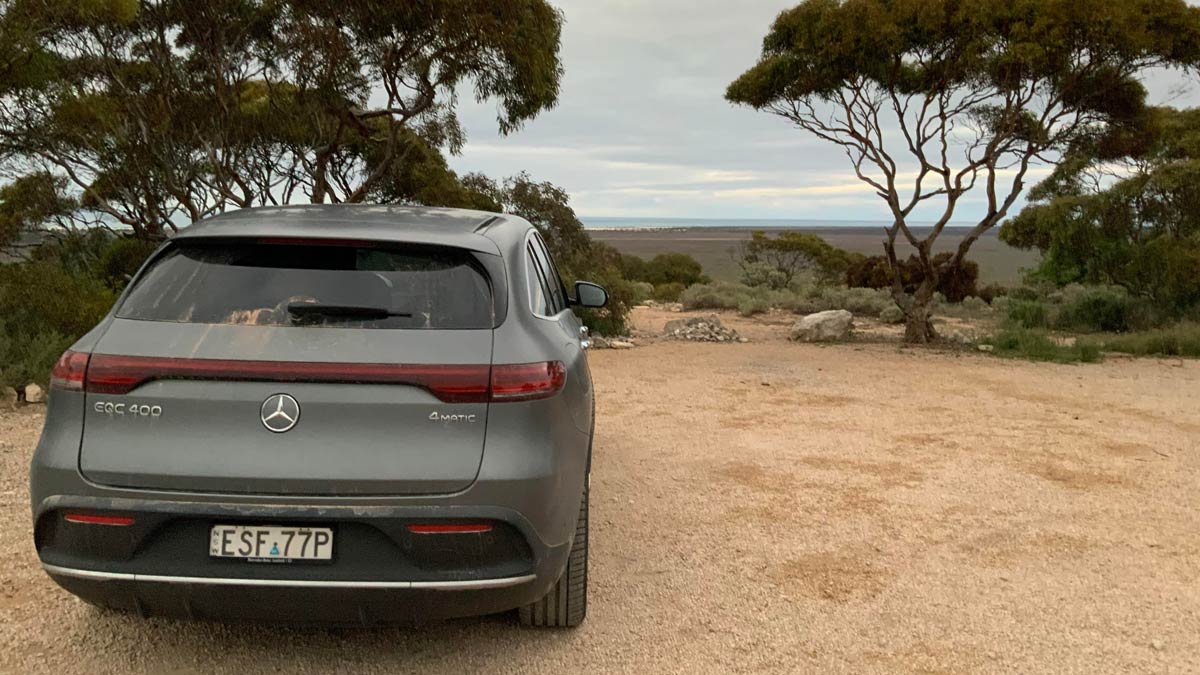
Overton considers herself more of an adventurer than a planner. As a technology consultant, taking on the new age of electric vehicles was not something that scared her. But it did mean that she ran into some touch-and-go moments out there on the road when it came to charging.
“I figured I’ll figure it out as I go along. I read that on the Nullarbor, I (would charge at) 32amp three-phase plugs. I was under the impression that I would show up and somehow there would be an umbilical cord attached to that 32amp three phase.
“I did not prepare enough. So I landed in Penong (about 70km west of Ceduna) and asked the lovely guy who has the caravan park, ‘So I read that you have a 32 amp three phase and I am here with my electric car’ and he’s like, ‘Well, sure, pull out your plug cord.'”
Having topped at Ceduna she wasn’t phased. “I had enough (range) that I was like, okay, well, I’m gonna go down to Cactus Beach and have some fun and I’ll figure it out.
“And I came back and it meant that along the Nullarbor, there were a few times where I had to sit for a day and a half to trickle charge the car, but, you know, I also had an electric scooter in the back and so, I’ve been off-road scootering around the Nullarbor.
“I’ve terrorised almost every town with my scooter …. so it just kind of made me slow down and go on little mini adventures and get to know people. I wasn’t always that zen about it – a few times, I was like, kill me now,” she says.
Hypermiling to the Nullarbor Roadhouse
There was one episode on the way to the Nullarbor where she had to practice “hypermiling” – driving slower to reduce energy consumption – to make it to the next stop.
After leaving Penong she found she did not have enough power to get to the Nullarbor Roadhouse. Having planned to arrive at the Yalata roadhouse along the way before sundown she found it closed. There were barriers up around the local community and cultural centre, and she hoped to find a plug there if only there was someone to help.
“So I’m walking around with my phone, and my phone charger. I’ve crossed the barricades, and I’m kind of hoping that someone will see me and yell at me so I can say, please, let me give you money and I’ll throw these extension cords at you and you can plug them in somewhere, and I’ll go back to the other side of the barrier, and I’ll leave in the morning, but no one shows up,” she says.
With light fading rapidly she weighed up sleeping in the car or flagging a truck down. She decided to tiptoe further in past the barriers and found a container with power. “So I pulled through the barricade hid behind this bush and this container and plugged in for a couple of hours,” she says.
“But now it’s getting really cold because it’s the Nullarbor and as it gets cold that affects the battery in significant ways – so, I sat on this trickle charge, pulling 1.7 kilowatts for two and a half hours,” she says.
With temperatures reaching five degrees, she says she thought, “I’m probably losing more than I’m gaining.” So she pulled out onto the highway and drove 50km an hour for three hours, pulling over when trucks approached.
“You can see when the road trains are coming in the distance because the whole sky lights up and you can see forever,” she says. Then she’d coast until she found a place that looked like it was safe to pull over, wait for the truck to go by and then get back on the road.
“I landed at the Nullarbor Roadhouse close to one o’clock, with 7kms left on the battery,” she says.
“Near the bathroom I found an outlet, plugged my car in, climbed into the car, woke up in the morning and explain what had happened and got a room from them for another day of charging,” she says, adding it was “a pretty intense experience.”
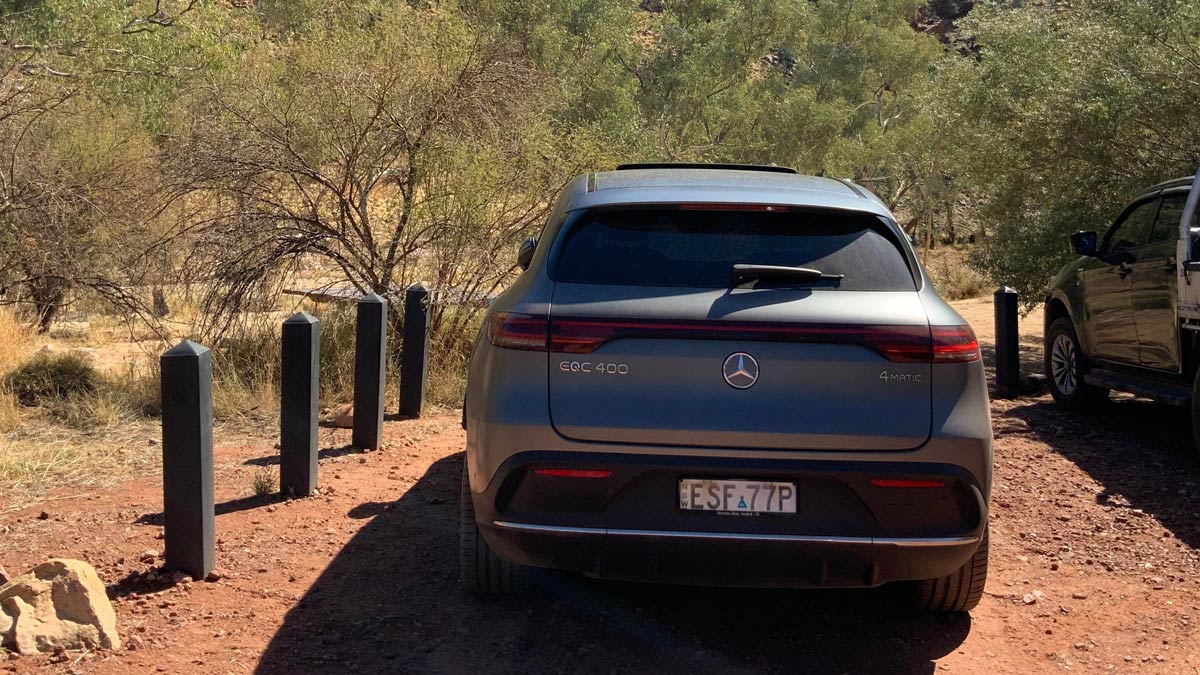
Drinking electrons through a straw
“As I crossed the Nullarbor I learned what I needed, so I ordered a proper charger that had multiple heads,” she says.
“And the multiple heads was key, because I ended up charging a lot in caravan parks on 15amp plugs as well. So I had a 15 amp, I had a 32amp three-phase that I used a lot.
“I wish I had a 20amp as well – that would have been really helpful.”
She says she did have some trouble explaining to caravan operators and the like that it didn’t make sense to charge her hourly for topping up the EQC battery.
“In Kings Canyon I charged on the caravan park’s standard powerpoint, because they were charging $20 an hour to use their 32-amp three-phase. And I did struggle a little bit as I got towards this side of the country, because the expectations around charging were built by Tesla people.
“And so it’s all based on the fact that they can consume a lot more power faster. And so I’d have to have these long conversations like alright, so I have an 80-kilowatt-hour battery.
“I don’t drink any more than they do. They just drink from a fire hose and I drink from a straw. And so you really think that I shouldn’t spend $200 to sit and charge for 10 hours? That’s nonsense. That’s crazy, right?” she says.
“So I’m like, well, I’ve paid for a caravan spot. I’m just going to charge on the caravan charger.”
Other than that encounter, many people – mainly of the husband kind – she ran into were just plain curious.
“It was usually the men, there weren’t a lot of women that were interested – I was a bit disappointed about that. I think it’s still a novelty. And even more so if it’s not a Tesla, because everyone is kind of focused on ‘electric vehicle means Tesla.’ And that’s not the case.”
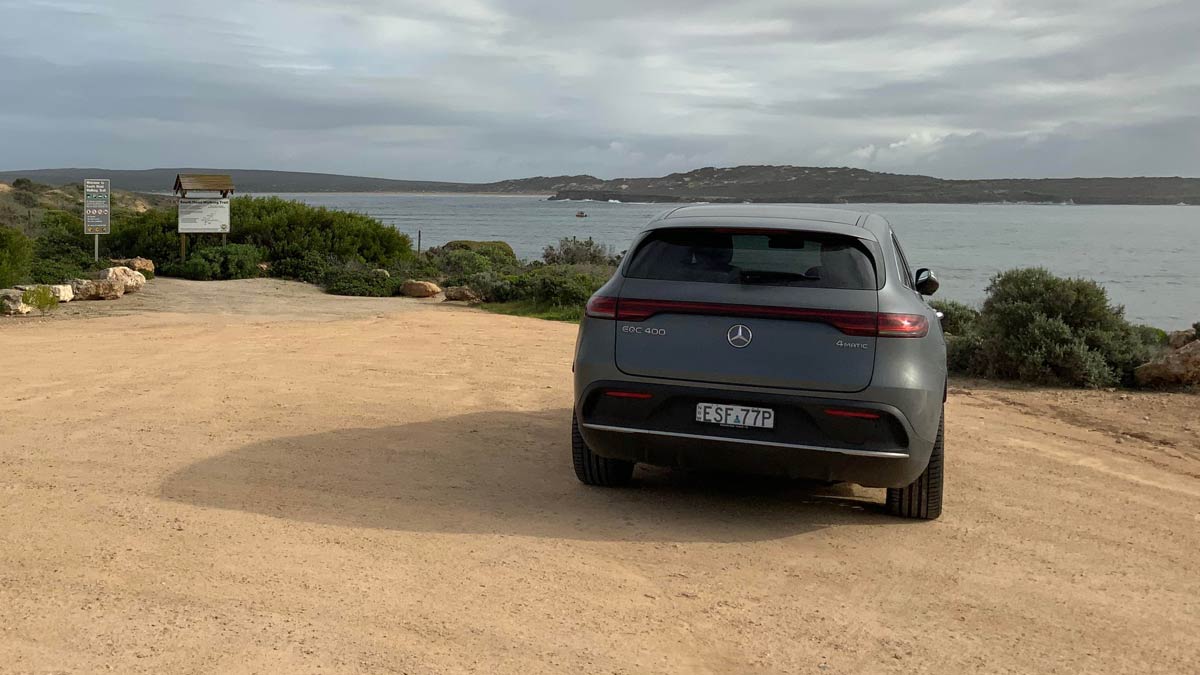
AC on-board charger faults and offline DC chargers
Overton did run into some trouble at fast-chargers because of the way they were recorded on smartphone apps.
“I had a fail in Kojonup (in south-west WA) that had one fast charger that I could use,” she says. “I was racing towards it and the Chargefox app said that it was offline. What it didn’t say is it was broken offline, it just looked as though it was being used.”
Thinking this meant it was working, and at the worst, she’d have to wait to use it, she arrived to find out was broken.
“And then I went to find one of two Tesla chargers that were there also and I got an error message. And it was the first time that I got an angry red exclamation point,” she says.
“I called all of my engineers and I’m like, ‘guys research the problem, like what’s going on? And the best they could come up with was, ‘This happens every once in a while with the EQCs, it’s likely related to temperature,’ but it meant it would not accept that Tesla destination charger type.”
Thankfully, the local Mitre 10 owner where the Tesla charger was located came out to help and his brother kindly offered to allow Overton to charge at their home.
“So now all of a sudden …. I’m sleeping in their guestroom and they’re making dinner and we’re having wine and I have new friends in Kojonup. But I am stressed out of my mind at that moment thinking if this keeps happening, I can’t trickle charge my way, you know, I might have to abort and at Perth catch a train and send the car back if this is going to be an ongoing issue,” she says.
Mercedes-Benz Perth came to the rescue and made Overton an emergency appointment. She was able to get just enough charge to get to the next DC charger, get a full charge and then sprinted to Perth, where they ran software updates.
This must have worked, because Overton says the problem didn’t crop up again. But she did have to be a little enterprising in finding charge points.
“I kept saying (to myself) you can always find a plug somewhere. There were a few bathrooms (where I pulled up) late at night and I unplugged the hand dryer and plugged my car in and fell asleep.”
“I didn’t do it often. There’s no one there to ask permission. I made a point of buying coffees in the morning, finding the bakery, putting some funds back into the spot that I had so kindly been allowed to steal power from overnight to get to where I needed to go – but those were few and far between,” she says.
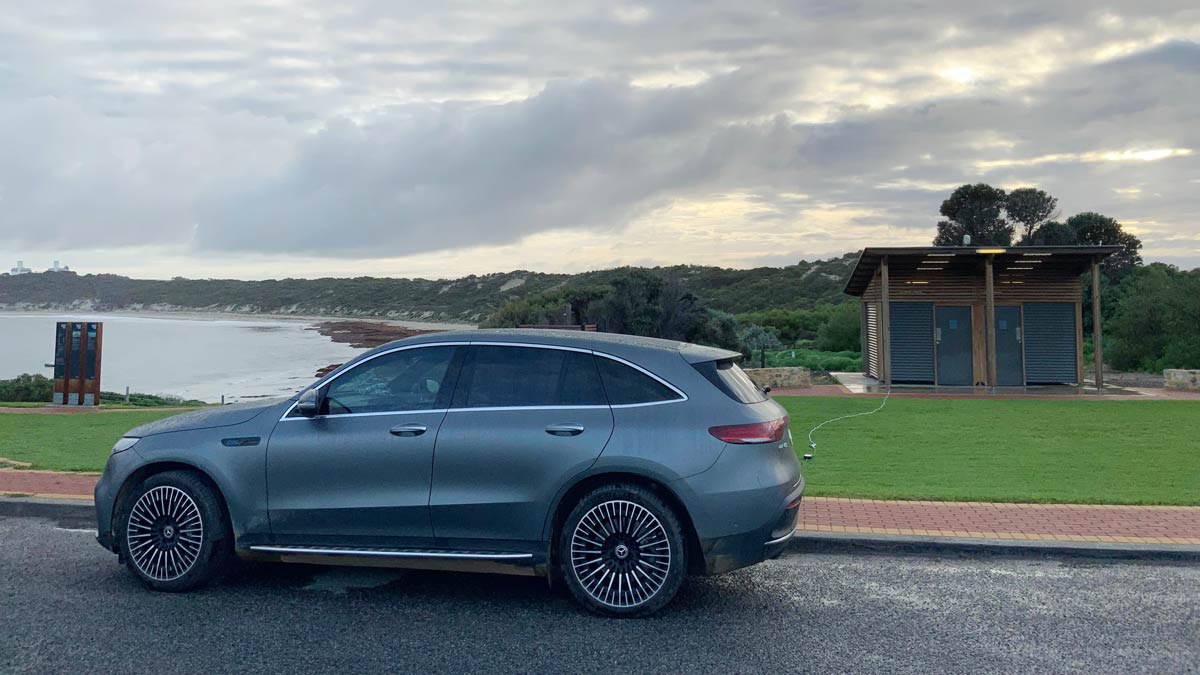
She says highlights of the journey were going to really out-of-the-way spots like Derby in northern WA. She did the Horizontal Falls day trip and loved Timber Creek.
“I like the top and the bottom the most. I really love the Nullarbor and I love that space. Between Broome and Darwin, there’s a lot of beautiful space in there. And I enjoyed being in that kind of wide open space where you really felt like, like you could see forever and, you know, everything was interesting,” she says.
“I love that I did spend a lot of time on the Ningaloo because I wanted to swim with Whale Sharks and see the humpbacks and do all that. I loved Esperance, I think Esperance is just spectacularly beautiful. And I’m really sad that I had to cut back to Perth, so I missed Albany and Denmark in that corner.”
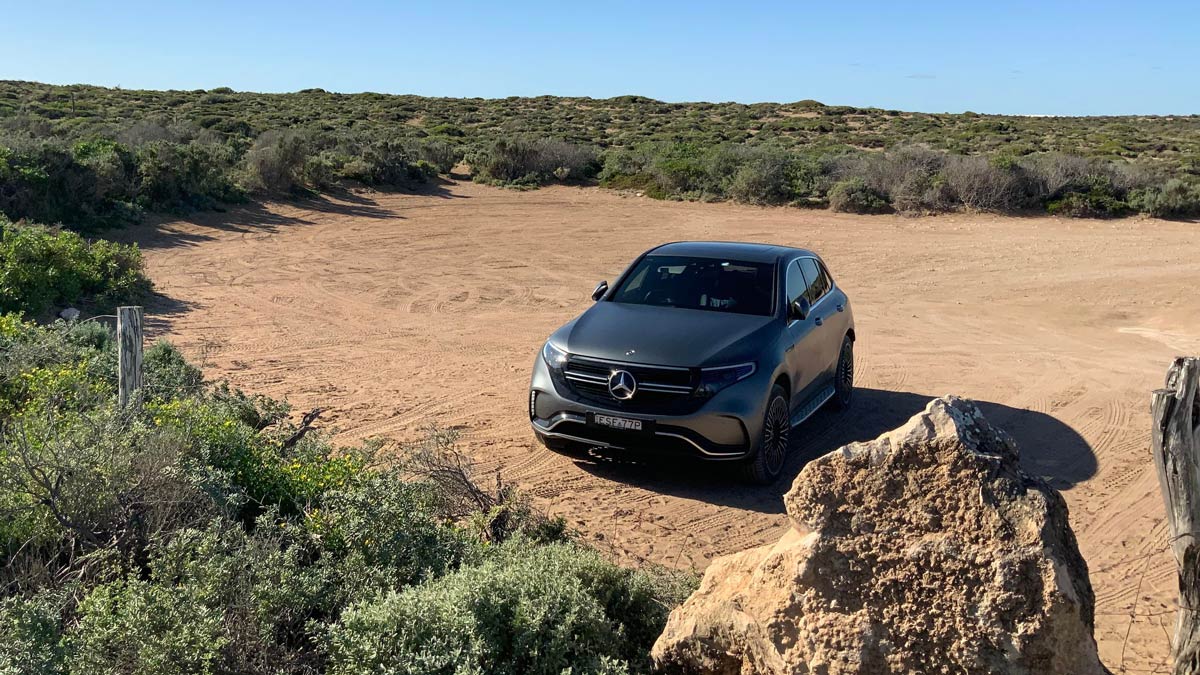
She says the trip took three months but only because she took her time. Whilst some big lappers have done it in as little as 17 days now, Overton says she would have done it in a little under two months if she had to.
She hasn’t tallied up sums but says although she saved money using the free complimentary charging she got via the Mercedes/Chargefox deal, she found the remote charging costs “wildly inconsistent.” All in all, she drove around 20,000km.
She thinks it’s important that local governments invest in EV charging infrastructure so more people can do the journey with the same amount of planning as is needed for a combustion engine car.
“I feel like it’s not such a big ask to put together a better fast charging network that we can use in more rural spaces,” she says.
“If I can go to a community and stay there for two hours in charge, I’m in all the shops, I’m looking around …. (towns) can certainly become a point of tourism if you have proper charging infrastructure.
“But I think it’s also the right thing to do for the local community. I just kind of see it as a win-win, but I feel one of the problems is you have to have local people vested in the maintaining of that infrastructure …. the same engineers who are building it, then need to be forced to run it. So that way what they build is runnable versus someone else’s problem.”
Note: The WA government will roll out a DC fast charging network by early 2024 using modular Kempower units. The NT government is yet to announce a network.
Electric Road Big Lappers
Source: TOCWA
| Driver | Start/End point | Completion Date | Vehicle |
| 1. Glen George | Perth | November 2011 | MG converted Blue |
| 2 Richard McNeall | Sydney | September 2016 | Tesla S Blue |
| 3. Jeff Johnson | Sydney | November 2016 | Nissan Leaf Blue |
| 4. Sylvia Wilson | Gladstone | July 2018 | Tesla S Blue |
| 5. Steve & Keita Burrell | Perth | August 2018 | Tesla S Titanium |
| 6. Harald Murphy | Perth | November 2018 | Tesla X Titanium |
| 7. Wiebe Wakker | Darwin/Sydney | March 2019 | VW converted Blue |
| 8. Richard Smith | Darwin | April 2019 | Tesla X White |
| 9. Linda Rohrs | Gold Coast | July 2019 | Tesla S Blue |
| 10. Rob & Robin Dean | Perth | November 2019 | Tesla S Blue |
| 11. Peter Hayes | Melbourne | December 2019 | Tesla 3 Silver |
| 12. John Paul | Melbourne | March 2020 | Tesla 3 Red |
| 13. Jules Boag | Sydney | May 2021 | Tesla S White |
| 14. Michelle & Terry Arzanikow | Ballarat | June 2021 | Tesla 3 White |
| 15. David McLeod | Warnambool | August 2021 | Tesla S Blue |
| 16. Phil Smith | Cairns | August 2021 | Tesla 3 Blue |
| 17. David Coates | Melbourne | September 2021 | Tesla 3 Blue |
| 18. Bill Gresham & John Phillips | Canberra | July 2022 | Hyundai Ioniq Red |
| 19. Jeff & Julie Wicks | Goldcoast | July 2022 | Tesla 3 White |
| 20. Tiff Overton | Central Coast NSW | August 2022 | Mercedes EQC400 Silver Grey |
| 21. Harald Murphy | Perth | September 2022 | Tesla Y White #AUSYtour |
| *22. Pete Petrovsky | Perth | *Pending | Tesla Y White #AUSYtour |
| Not confirmed: Hilly Andy | ? Perth | 2021 | Tesla 3 Blue |

Bridie Schmidt is associate editor for The Driven, sister site of Renew Economy. She has been writing about electric vehicles since 2018, and has a keen interest in the role that zero-emissions transport has to play in sustainability. She has participated in podcasts such as Download This Show with Marc Fennell and Shirtloads of Science with Karl Kruszelnicki and is co-organiser of the Northern Rivers Electric Vehicle Forum. Bridie also owns a Tesla Model Y and has it available for hire on evee.com.au.

